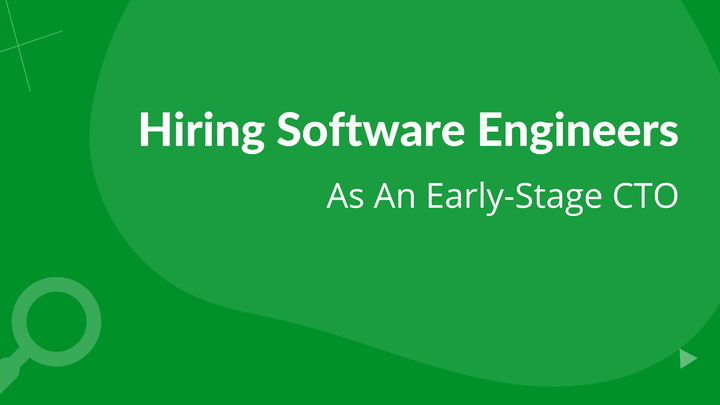Hiring Engineers as an Early-Stage CTO

Hiring engineers at an early-stage startup is a different game. There’s no structured onboarding, no product team handing off detailed specs, and no safety net of internal tools to make development easier.
You need people who can figure things out, build fast, and communicate well. And as the CTO, it’s on you to find them.
I’ve been through this process, and I’ve learned a few things along the way. Here’s how to approach hiring your first few engineers.
Your First Engineer (or Just You?)
If you’re the CTO, your first job is to build the MVP yourself. That’s why, ideally, you’re full-stack. You don’t need to be amazing at everything, but you do need to be good enough to get the product live without bottlenecks.
If you’re hiring a first engineer instead of (or alongside) yourself, they should also be full-stack. At this stage, specialization slows you down. You need people who can touch everything—frontend, backend, infra—without waiting on someone else.
Your Next Hires: Full-Stack If Possible
Once the MVP is out (or close), it’s time to hire. Full-stack engineers are ideal, but most engineers aren’t truly full-stack. They’ll be stronger in either frontend or backend.
So how do you decide who to bring on?
- If you’re stronger in one area, hire someone to fill the gap.
- If you’re balanced, lean towards hiring a backend-heavy full-stack engineer first. Backend work tends to pile up faster.
The Backend-Frontend Balance (2:1 Ratio?)
Most early-stage startups end up needing more backend than frontend engineers. Backend work stacks up quickly—APIs, databases, integrations, security, scaling. Meanwhile, frontend is often bottlenecked by design work.
A solid rule of thumb:
👉 2 backend engineers for every 1 frontend engineer.
But this depends on your product:
- API-heavy or integration-heavy? → You’ll need even more backend.
- UI-driven or highly interactive? → You’ll need a stronger frontend team sooner.
Keep an eye on where bottlenecks form and adjust hiring accordingly.
When to Hire a Designer
Early-stage UI is usually rough. And that’s okay. Your users care more about solving their problem than whether the buttons are perfectly spaced.
At some point, though, you’ll want a designer to clean things up. When you do, make sure you have enough frontend engineers to implement their designs. Otherwise, you’ll end up with a Figma graveyard—beautiful mockups that never make it to production because engineering is overloaded.
Hire Senior Engineers First
Your first few hires should be senior enough to own features end-to-end. Ask yourself:
✅ Can they build an entire feature without much hand-holding?
✅ Will they reach out when they’re stuck, but not before trying to solve the problem?
✅ Do they think about trade-offs and make good technical decisions?
✅ Do they focus on what actually matters to the customer instead of overengineering?
Early-stage engineering is all about speed and pragmatism. You need people who solve problems efficiently, not those who get lost in unnecessary abstractions.
Hire Great Communicators
At this stage, technical skill isn’t enough. Your engineers need to communicate well. That means:
- Writing clear PRs and documentation.
- Explaining technical decisions in a way that makes sense.
- Thinking through product trade-offs, not just code.
Poor communication slows the whole team down. Strong communicators make everything run smoother.
Final Thoughts
Hiring early engineers isn’t just about finding good coders. It’s about finding people who can build, own features, and communicate well.
As CTO, your job is to:
- Be (or hire) a full-stack first engineer.
- Prioritize full-stack hires, but complement your strengths.
- Expect a backend-heavy team (2:1 BE:FE), but adjust based on bottlenecks.
- Bring in a designer only when you have enough frontend bandwidth.
- Hire senior engineers who can own features without overengineering.
- Make sure every early hire is a strong communicator.
Your early hires will define your team’s culture, speed, and ability to execute. Choose wisely. 🚀
This post was originally published on February 9, 2025Get a newsletter you'll look forward to
Resources to help you grow as an engineer and leader
100% free. No spam. Unsubscribe any time.